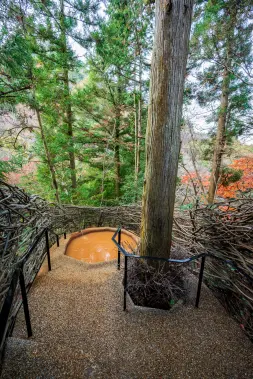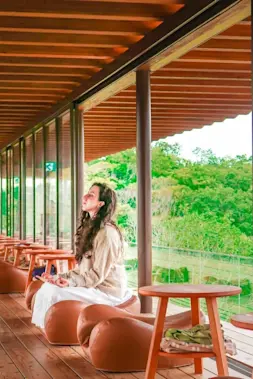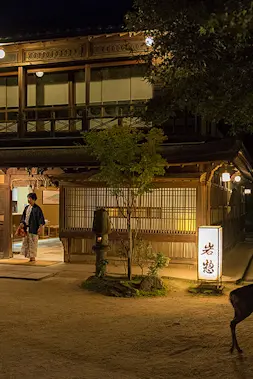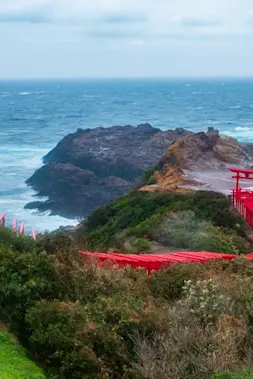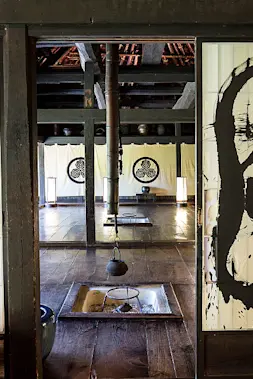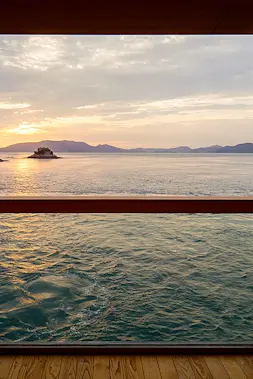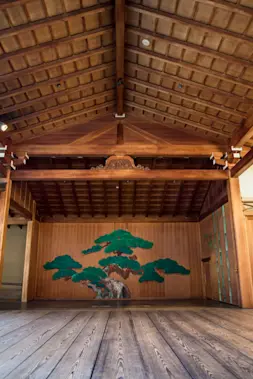Relaxing Stay
Art-Infused Experiences at Motonosumi Shrine and Nagato Yumoto Onsen

-
- DESTINATION NAME
- Yamaguchi
-
- RELATED TAGS
-
- LAST UPDATED
- 05 April, 2021
As I peered down the rocky cliff towards Motonosumi Shrine, its emblematic vermillion torii Shinto gates shone through the turbulent ocean weather. Even as the ocean breeze picked up in sudden urgency, the Sea of Japan sparkled a cobalt blue hue — a striking contrast against the brilliant torii gates — and I was struck by its sheer beauty and grandeur. It’s undeniable that Yamaguchi prefecture is home to some spectacularly beautiful sights like these, but during my visit to the Nagato region, I was about to find out how much of this artful fusion of nature and spiritualism ran within the area. With my day ending in an overnight stay at Nagato Yumoto Onsen, Yamaguchi’s oldest hot springs, I was eager to jump right in to discover what surprises awaited me.
Motonosumi Shrine
My introduction to the Nagato region started along the secluded coastline of Yamaguchi at Motonosumi Shrine. The shrine’s 123 tightly-knit torii Shinto gates wind along 100 meters of a cliff bluff, descending into the open arms of the Sea of Japan. This spectacular cliff-side location is attributed to a local legend describing a fox spirit delivering a message from the Shinto god of rice, instructing a Nagato local to build the shrine along this rugged coast. Whether it was divine intervention or not, I couldn’t help but think there was an artistic decision in the shrine’s scenic location to make the surrounding views part of the shrine’s final masterful composition.
This awe-inspiring structure resulted from 10 years of building and is said to bring visitors good luck in business, fishing, travel, and pregnancy. If you walk down the main torii gate, a donation box perched at the top of the gate is another chance for you to win some additional luck. Make a wish, aim high, and if you’re lucky enough to flip your coin into the box, you may have your wish come true.
Visit Motonosumi Shrine in the summer, and you may encounter crystal blue skies and green slopes. However, you can enjoy the shrine at any time of year. Even on stormy days, the gates contrast their emblematic hue of vibrant red against the blue ocean, making its crown as one of “31 Most Beautiful Places in Japan” by CNN Travel even more understandable. Unlike some other famous shrines, Motonosumi Shrine’s off-the-beaten-path destination along Yamaguchi’s western coastline means that you’ll enjoy a more crowd-free experience of this breathtaking landmark.
Nagato Yumoto Onsen, the Oldest Hot Springs in Yamaguchi
Regardless of whether it’s a gentle ocean breeze or a blustery wind that greets you at Motonosumi Shrine, guaranteed solace is only a 15-minute drive away at Yamaguchi’s oldest onsen hot springs, Nagato Yumoto Onsen (長門湯本温泉). Otozure River runs through the middle of town with riverside deck terraces and foot baths for you to enjoy as you take pleasure in the beautiful river sceneries. Along the riverbank is a selection of traditional Japanese-style ryokan inns and modern luxury accommodations mixed in with old Japanese houses renovated into trendy cafes and bars. You can sample the region’s local fare, including their rich and nutty buckwheat noodles, served on traditional Hagi-ware pottery made in the neighboring Hagi city.
As nighttime fell upon us, the orange bridges and bamboo-lined stairways lit up into illuminated walkways for a lovely evening ambiance — what I deem an ideal way to spend a romantic night strolling through town before settling into the onsen.
Onto, Nagato Yumoto’s Oldest Onsen
At the heart of the Nagato Yumoto Onsen is Onto (恩湯), where I experienced a uniquely immersive onsen in the town’s famed waters. Considered the town’s oldest hot spring, this 600-year-old onsen gurgles spontaneously from the bedrock without the help of human construction — a rarity among onsen in Japan. Onto’s main building and matching restaurant was built in March 2020 and are fine examples of contemporary architecture, with large windows, spacious rooms, and minimal interior design.
This ancient onsen is fabled to have been discovered by a priest on a divine revelation. Indeed, there was a profoundly spiritual aspect to the space you have to see for yourself to believe. After paying my entrance fee and washing at the shower station, I entered the bath’s separate room. The steel-grey tiled bath and sloping white ceiling transitioned into a display room of wood-paneled walls showcasing the original bedrock and bubbling hot spring source. Holy rope with paper streamers called yorishiro strung across the room added a sacred significance, made even more so by the stone statue of Sumiyoshi Daimyojin, the Shinto god of the sea, lit from concealed lights within the floor.
As I sunk into the deep bath, water overflowed into the drain, creating a resounding echo, and I immediately imagined the god’s deep grumblings under the bedrock. In what I’d consider one of the most artfully-immersive, profoundly spiritual onsen experiences I’ve had, a hot spring experience like Onto wouldn’t have been out of place in a contemporary art museum. When I asked Otani-san, a Nagato Yumoto native and co-owner of Onto, if there were any artistic endeavors in designing the onsen this way, I learned it was much more personal history.
“I used to gaze at a similar statue when I visited this onsen as a boy,” said Otani-san. “The former Onto building was dilapidated from years of use. It was heartbreaking seeing it falling apart like that, so when the city reached out for bids from interested parties to renovate Onto, I put up my hand and offered my services. When we started renovations and peeled back all the layers of wood, we made the startling discovery of the natural springs bubbling up from the bedrock. I was amazed! All that time, this wonderfully rare natural onsen was hidden under that old building. I’m just finally giving it the attention it deserves.”
Onto is clearly a labor of love, echoed in the passion of Otani-san and the friendliness of the staff. It’s this passion, along with Yamaguchi’s unique combination of art, nature, and spirituality, that stands out in my mind. If you’re looking for a trip to sweep you off your feet with stunning ocean views or a soak in a spiritually-inspired onsen experience, Yamaguchi has all the stops to satisfy your needs.
How to Get to Motonosumi Shrine and Nagato Yumoto Onsen
To get to Nagato Yumoto Onsen from Tokyo, take a JR Shinkansen train to Shin-Yamaguchi Station (4.5 hours), then transfer to the local train line to Asa Station. From there, catch the local train headed to Mine city and get off at Nagato-Yumoto Station. Motonosumi Shrine is a 25-minute taxi ride Nagato-Yumoto Station. If you’re traveling by car, it will give you the best opportunity to explore the surrounding area more freely. It takes about two hours from Kyoto or Shin-Osaka station to Shin-Yamaguchi station by JR Shinkansen.
Things to See and Do in Yamaguchi
If hiking through unusual limestone landscapes and underground caves take your fancy, you won’t be disappointed with a visit to Akiyoshidai Quasi-National Park. This park is home to the highest concentration of karst limestone formations and the longest limestone cave in the nation, with plenty of hiking trails to suit any outdoor adventurer. For more things to see in Yamaguchi Prefecture, read our separate article on the top places to see and do while you’re traveling in the area.
Photographs and text by Mika Senda
RELATED DESTINATION
Yamaguchi
Yamaguchi is surrounded by ocean, mountains and rivers and is characterized by its climate, which is comfortable throughout the year. Its natural scenery, which includes some 1,500 kilometers of coastline, is a cut above. The prefecture has Kintaikyo Bridge, one of the three most famous bridges in Japan, and other tourist attractions, and its fugu (pufferfish) is famous as a winter dish.



































